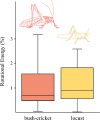Control of high-speed jumps in muscle and spring actuated systems: a comparative study of take-off energetics in bush-crickets (Mecopoda elongata) and locusts (Schistocerca gregaria)
- PMID: 37857900
- PMCID: PMC10613148
- DOI: 10.1007/s00360-023-01524-2
Control of high-speed jumps in muscle and spring actuated systems: a comparative study of take-off energetics in bush-crickets (Mecopoda elongata) and locusts (Schistocerca gregaria)
Abstract
The Orthoptera are a diverse insect order well known for their locomotive capabilities. To jump, the bush-cricket uses a muscle actuated (MA) system in which leg extension is actuated by contraction of the femoral muscles of the hind legs. In comparison, the locust uses a latch mediated spring actuated (LaMSA) system, in which leg extension is actuated by the recoil of spring-like structure in the femur. The aim of this study was to describe the jumping kinematics of Mecopoda elongata (Tettigoniidae) and compare this to existing data in Schistocerca gregaria (Acrididae), to determine differences in control of rotation during take-off between similarly sized MA and LaMSA jumpers. 269 jumps from 67 individuals of M. elongata with masses from 0.014 g to 3.01 g were recorded with a high-speed camera setup. In M. elongata, linear velocity increased with mass0.18 and the angular velocity (pitch) decreased with mass-0.13. In S. gregaria, linear velocity is constant and angular velocity decreases with mass-0.24. Despite these differences in velocity scaling, the ratio of translational kinetic energy to rotational kinetic energy was similar for both species. On average, the energy distribution of M. elongata was distributed 98.8% to translational kinetic energy and 1.2% to rotational kinetic energy, whilst in S. gregaria it is 98.7% and 1.3%, respectively. This energy distribution was independent of size for both species. Despite having two different jump actuation mechanisms, the ratio of translational and rotational kinetic energy formed during take-off is fixed across these distantly related orthopterans.
Keywords: Biomechanics; LaMSA; MA; Orthoptera; Pitch.
© 2023. The Author(s).
Conflict of interest statement
The authors declare no competing interests.
Figures





Similar articles
-
Control of high-speed jumps: the rotation and energetics of the locust (Schistocerca gregaria).J Comp Physiol B. 2023 Mar;193(2):145-153. doi: 10.1007/s00360-022-01471-4. Epub 2023 Jan 30. J Comp Physiol B. 2023. PMID: 36715704 Free PMC article.
-
Jumping and kicking in bush crickets.J Exp Biol. 2003 Mar;206(Pt 6):1035-49. doi: 10.1242/jeb.00214. J Exp Biol. 2003. PMID: 12582146
-
The energetics of the jump of the locust Schistocerca gregaria.J Exp Biol. 1975 Aug;63(1):53-83. doi: 10.1242/jeb.63.1.53. J Exp Biol. 1975. PMID: 1159370
-
Chemical Ecology and Olfaction in Short-Horned Grasshoppers (Orthoptera: Acrididae).J Chem Ecol. 2022 Feb;48(2):121-140. doi: 10.1007/s10886-021-01333-3. Epub 2022 Jan 10. J Chem Ecol. 2022. PMID: 35001201 Review.
-
Cultural significance of locusts, grasshoppers, and crickets in sub-Saharan Africa.J Ethnobiol Ethnomed. 2022 Mar 26;18(1):24. doi: 10.1186/s13002-022-00524-w. J Ethnobiol Ethnomed. 2022. PMID: 35346258 Free PMC article. Review.
Cited by
-
Jumping up a level: Target distance and angle estimation facilitates successful landing in a jumping glass katydid.iScience. 2025 May 23;28(6):112738. doi: 10.1016/j.isci.2025.112738. eCollection 2025 Jun 20. iScience. 2025. PMID: 40538435 Free PMC article.
References
-
- Bailey NTJ (1981) Statistical methods in biology, 2nd ed. Hodder & Stoughton
Publication types
MeSH terms
Grants and funding
LinkOut - more resources
Full Text Sources

